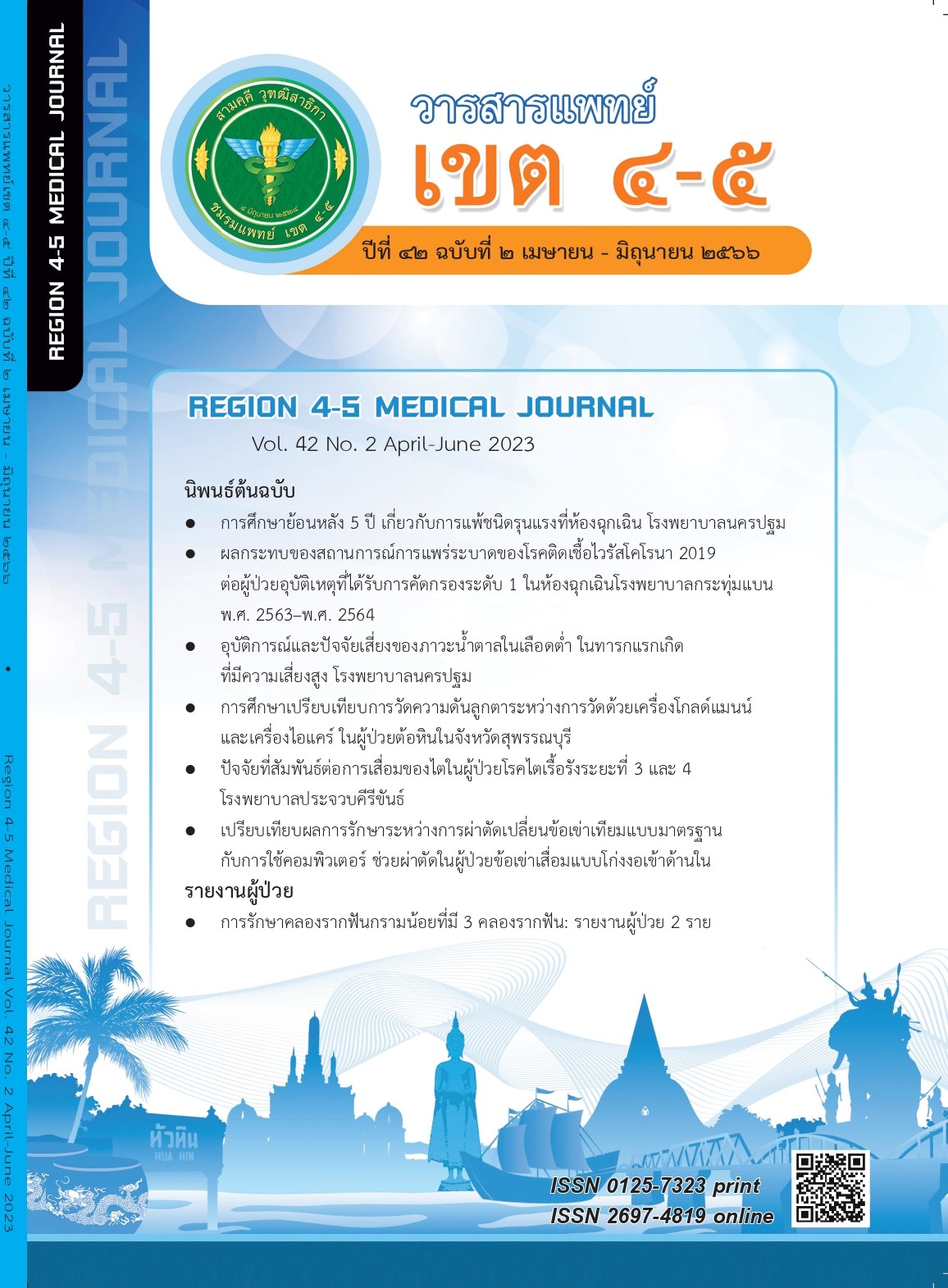เปรียบเทียบผลการรักษาระหว่างการผ่าตัดเปลี่ยนข้อเข่าเทียมแบบมาตรฐานกับการใช้คอมพิวเตอร์ ช่วยผ่าตัดในผู้ป่วยข้อเข่าเสื่อมแบบโก่งงอเข้าด้านใน
บทคัดย่อ
วัตถุประสงค์: เพื่อเปรียบเทียบผลการรักษาทางคลินิกและเอกซเรย์ระหว่างการผ่าตัดเปลี่ยนข้อเข่าเทียมแบบมาตรฐานกับการใช้คอมพิวเตอร์ช่วยผ่าตัดในผู้ป่วยข้อเข่าเสื่อมแบบโก่งงอเข้าด้านใน
วิธีการศึกษา: ศึกษาย้อนหลังของผู้ป่วยข้อเข่าเสื่อมที่ได้รับการผ่าตัดเปลี่ยนข้อเข่าเทียมแบบปฐมภูมิในโรงพยาบาลนครปฐมตั้งแต่ มกราคม ค.ศ. 2019 ถึง ธันวาคม ค.ศ. 2021 จำนวน 232 เข่าแบ่งเป็นกลุ่มที่ผ่าเข่าแบบมาตรฐาน 150 เข่า และกลุ่มที่ใช้คอมพิวเตอร์ช่วยผ่าตัด 82 เข่า โดยมีศัลยแพทย์จำนวน 5 คนที่ผ่าเข่าแบบมาตรฐานและมี 2 คน ใน 5 คนนี้ที่ผ่าเข่าแบบใช้คอมพิวเตอร์ช่วยผ่าตัด ข้อมูลที่ใช้ศึกษา ได้แก่ เพศ อายุ ดัชนีมวลกาย ระยะเวลาติดตาม ตำแหน่งแกนขา ระยะเวลาผ่าตัด อัตราการเสียเลือดหลังผ่าตัด และคะแนนฟังก์ชั่นเข่าหลังผ่าตัด
ผลการศึกษา: จากการวิเคราะห์ทางสถิติพบว่า อายุ ระยะเวลาติดตาม ดัชนีมวลกาย และเพศ ของทั้ง 2 กลุ่มไม่มีความแตกต่างกัน ในกลุ่มที่ใช้คอมพิวเตอร์ช่วยผ่าตัดมีระยะเวลาการผ่าตัดที่มากกว่า แต่ก็มีอัตราการเสียเลือดน้อยกว่ากลุ่มที่ไม่ใช้คอมพิวเตอร์ช่วยผ่าตัด ในกลุ่มข้อเข่าเสื่อมที่โก่งงอเข้าด้านในแบบน้อย (176° ≤ มุมฟีเมอร์ทิเบีย < 180°) แบบรุนแรง (185° ≤ มุมฟีเมอร์ทิเบีย < 190°) และแบบชัดเจน (มุมฟีเมอร์ทิเบีย ≥ 190°) ผู้ป่วยทั้ง 2 กลุ่มไม่มีความแตกต่างกันอย่างมีนัยสำคัญในเรื่องของตำแหน่งแกนขาหลังผ่าตัดและคะแนนฟังก์ชั่นเข่าหลังผ่าตัด ผู้ป่วยเข่าเสื่อมที่โก่งงอแบบปานกลาง (180° ≤ มุมฟีเมอร์ทิเบีย < 185°) กลุ่มที่ใช้คอมพิวเตอร์ช่วยผ่าตัดมีแนวโน้มที่จะเกิดเข่าโก่งงอเข้าด้านในหลังผ่าตัดมากกว่ากลุ่มที่ไม่ใช้คอมพิวเตอร์ช่วยผ่าแต่เรื่องคะแนนฟังก์ชั่นเข่าหลังผ่าตัดไม่แตกต่างกันใน 2 กลุ่ม
สรุป: ระยะเวลาติดตามระยะสั้น (1 ปี) การใช้คอมพิวเตอร์ช่วยผ่าตัดในข้อเข่าเทียมให้ผลลัพธ์ทางคลินิกและเอกซเรย์ไม่แตกต่างกันกับการผ่าตัดแบบมาตรฐานในผู้ป่วยข้อเข่าเสื่อมแบบโก่งงอเข้าด้านใน ในระยะความรุนแรงต่างๆ ยกเว้นกลุ่มที่โก่งงอแบบปานกลางกลุ่มที่ใช้คอมพิวเตอร์ช่วยผ่ามีแนวโน้มที่จะเกิดการโก่งงอเข้าด้านในหลังผ่าตัดมากกว่ากลุ่มที่ผ่าตัดแบบมาตรฐาน กลุ่มที่ใช้คอมพิวเตอร์ช่วยผ่าตัดเปลี่ยนข้อเข่าเทียมจะใช้เวลาผ่าตัดมากกว่าแต่เสียเลือดน้อยกว่ากลุ่มการผ่าตัดแบบมาตรฐาน
เอกสารอ้างอิง
Shah SM. After 25 years of computer-navigated total knee arthroplasty, where do we stand today? Arthroplasty. 2021;3(1):41. DOI: 10.1186/s42836-021-00100-9
Burnett RSJ, Barrack RL. Computer-assisted total knee arthroplasty in currently of no proven clinical benefit: a systematic review. Clin Orthop Relat Res. 2013;471(1):264–76. doi: 10.1007/s11999-012-2528-8.
Luis NM, Varatojo R. Radiological assessment of lower limb alignment. EFORT Open Rev. 2021;6(6):487–94. doi: 10.1302/2058-5241.6.210015.
Matsumoto T, Hashimura M, Takayama K, et al. A radiographic analysis of alignment of the lower extremities-initiation and progression of varus-type knee osteoarthritis Osteoarthritis Cartilage. 2015;23(2):217–23. DOI: 10.1016/j.joca.2014.11.015
Insall JN, Dorr LD, Scott RD, et al. Rationale of the knee Society clinical rating system. Clin Orthop Relat Res. 1989;248:13-4.
Han SB, Kim HJ, Kim TK, et al. Computer navigation is effective in reducing blood loss but has no effect on transfusion requirement following primary total knee arthroplasty a meta-analysis. Knee Surg Sports Traumatol Arthrosc. 2016;24(11):3474–81. doi: 10.1007/s00167-016-4053-x.
Lee DY, Park YJ, Hwang SC, et al. No differences in mid- to long-term outcomes of computer-assisted navigation versus conventional total knee arthroplasty. Knee Surg Sports Traumatol Arthrosc. 2020;28(10):3183–92. doi: 10.1007/s00167-019-05808-5.
Kamat YD, Aurakzai KM, Adhikari AR, et al. Does computer navigation in total knee arthroplasty improve patient outcome at midterm follow-up? Int Orthop. 2009;33(6):1567–70. doi: 10.1007/s00264-008-0690-0.
Cho Y, Shin HK, Kim E, et al. Postoperative radiologic outcome comparison between conventional and computer-assisted navigation total knee arthroplasty in extra-articular tibia vara. J Orthop surg (Hong Kong). 2020;28(1):2309499020905702. doi: 10.1177/2309499020905702.
Maniwa K, Ishibashi Y, Tsuda E, et al. Accuracy of image-free computer navigated total knee arthroplasty is not compromised in severely deformed varus knees. J Arthroplasty. 2013;28(5):802–6. doi: 10.1016/j.arth.2012.09.014.
Takasaki M, Matsuda S, Fukagawa S, et al. Accuracy of image-free navigation for severely deformed knees Knee Surg Sports Traumatol Arthrosc, 2010;18(6)763–8. doi: 10.1007/s00167-009-0944-4.
Kraus VB, Vail TP, Worrell T, et al. A comparative assessment of alignment angle of the knee by radiographic and physical examination methods. Arthritis Rheum 2005;52:1730–5. DOI: 10.1002/art.21100
Thomas LDGR, Geist JGB, Lucena RL, et al. Radiographic Evaluation of Postoperative Alignment in Total Knee Arthroplasty. Rev Bras Orthop (Sao Paulo). 2021;57(4):656–60. doi: 10.1055/s-0041-1726061
Lee SS, Seo MK, Kim IS, et al. Comparison of Survival Rate and Outcomes Between Conventional and Navigation-Assisted Primary Total Knee Arthroplasty in Severe Varus Knees A Minimum 10-Year Follow-Up. J Arthroplasty. 2022;37(11):2164–70. DOI: 10.1016/j.arth.2022.05.03
ดาวน์โหลด
เผยแพร่แล้ว
รูปแบบการอ้างอิง
ฉบับ
ประเภทบทความ
สัญญาอนุญาต

อนุญาตภายใต้เงื่อนไข Creative Commons Attribution-NonCommercial-NoDerivatives 4.0 International License.
ลิขสิทธิ์บทความเป็นของผู้เขียนบทความ แต่หากผลงานของท่านได้รับการพิจารณาตีพิมพ์ลงวารสารแพทย์เขต 4-5 จะคงไว้ซึ่งสิทธิ์ในการตีพิมพ์ครั้งแรกด้วยเหตุที่บทความจะปรากฎในวารสารที่เข้าถึงได้ จึงอนุญาตให้นำบทความในวารสารไปใช้ประโยชน์ได้ในเชิงวิชาการโดยจำเป็นต้องมีการอ้างอิงถึงชื่อวารสารอย่างถูกต้อง แต่ไม่อนุญาตให้นำไปใช้ในเชิงพาณิชย์




